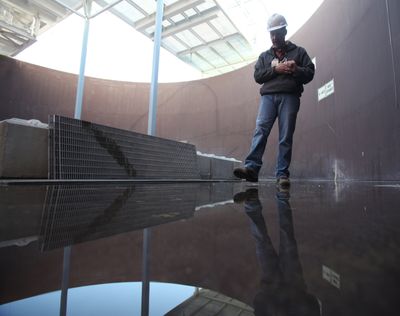Hanford design challenged

RICHLAND – It sounds like a sci-fi thriller: Dangerous gases build up in a giant drum of nuclear waste. It explodes and spews contamination, threatening workers or the public. Or it cripples a facility that cost taxpayers $12.2 billion.
It could happen at Hanford’s nuclear waste disposal plant if radioactive material isn’t kept stirred.
So engineers years ago proposed a solution. Inside the plant’s giant drums they would put pumps that work like giant turkey basters. Using air and suction, they would slurp up and spit out radioactive sludge to keep it constantly churned.
But despite hundreds of millions of tax dollars and nearly a decade of effort, builders haven’t proved these “pulse-jet mixers” will work and work safely, according to interviews, audits, internal and external project documents and e-mails.
The effort to perfect this mixing system is a case study of Hanford’s engineering challenges and helps explain why the site’s waste-to-glass project often seems to be in crisis. Tracing this one technical problem reveals how cutting-edge technology and management missteps have led to setbacks, delays, cost-overruns, investigations and accusations of malfeasance.
Walt Tamosaitis, an engineer and high-level manager with one of Hanford’s contractors, charges that speaking out about it cost him his career. He since has filed a whistle-blower complaint. An investigation is under way.
Neither the federal Department of Energy nor its contractors will comment on his accusation. They maintain they’ve solved this mixing problem.
But university scientists and experts with several federal offices aren’t convinced.
Hanford’s treatment plant is supposed to run waste from leaky underground tanks into large drums in a shopping-mall-size building. There, radioactive elements will be separated and turned into glass.
Along the way, when waste sits in the plant’s dozens of holding vessels, pulse-jet mixers will stir them.
Here’s why: Hanford’s waste holds up to 1,700 pounds of plutonium-239, scattered among 53 million gallons of other poisons. It is a heavy element and will want to settle at the bottom of these drums. Over time, too many particles could gather and trigger a chain reaction.
It happened in Japan in 1999: Reprocessing-plant workers combined too much uranium. Suddenly, there was a flash of blue light and an intense surge of radiation. Two workers were vomiting within the hour. One died in 12 weeks, another in seven months.
That’s just one possibility. Particles of plutonium or, for that matter, any other heavy element also could build up and trap and release hydrogen that could then explode.
Stirring ensures none of the particles accumulates.
But jet mixers have never been used on this scale or with such a mix of chemicals and radioactive isotopes.
And some of Hanford’s holding vessels are installed in “black cells,” areas already expected to be so hot with radioactivity that no human or equipment can get in to fix them. That means nothing must break down during decades of operation.
Plus, these mixers have competing jobs. They must be strong enough to keep waste from clumping and delicate enough to not spit out air or particles with too much force. That could ruin the pumps or damage the holding drums, potentially disabling the entire $12.2 billion plant.
Jet mixers were tested back in 2000, but questions emerged. Plant design and construction continued while engineers tried to answer them.
The Department of Energy and Bechtel National, the lead contractor, have agreed to conduct new tests.
Just before Christmas, the safety board outlined precisely how it hopes those tests will go because others “have been insufficient.” The board reiterated its fear of explosions and chain reactions.
Those large-scale tests may take two years.
Meanwhile, plant construction will continue.